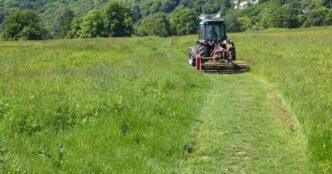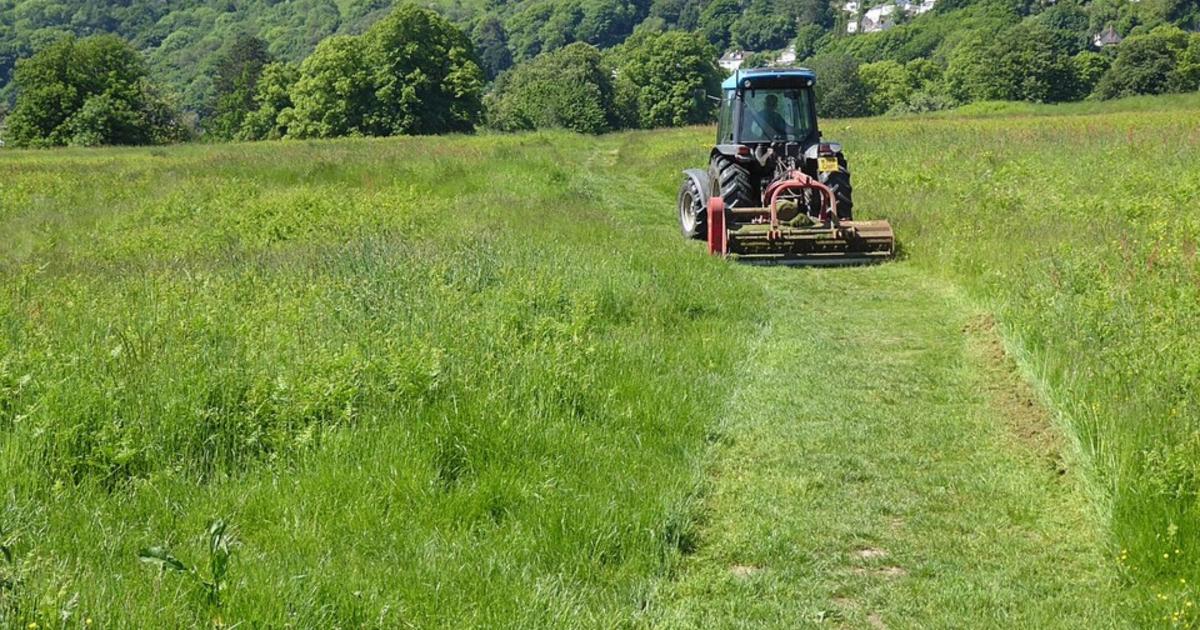Up to 34% of the agricultural area of the EU consists of permanent grasslands. These habitats have a dual role in supporting biodiversity and serving agricultural functions, such as grazing and hay production. Their role in maintaining wild pollinators such as bees and butterflies also benefits agriculture where crops – especially fruit – rely on them for pollination. However, in the 2020 European Environment Agency State of nature in the EU report, the conservation status of nearly half (49%) of grasslands was assessed as ‘bad’. Meanwhile, a dramatic decline in pollinating insects has been reported in Europe (and globally) in recent decades, in several key habitats, including grasslands[1].
Semi-natural grasslands require ongoing management to prevent the growth of woody vegetation and maintain their distinctive characteristics. Typically, land managers do this through regular grazing or mowing. Mowing an entire area at once, however, can have a negative impact on biodiversity as sources of food and shelter are abruptly removed. This problem can be mitigated by mowing only part of the total area on each occasion. One way of achieving this is in the rotational or ‘block’ mowing system, where all parts of the plot are cut at least once a year, but a patch is left unmown each time. Traditionally, a rectangular patch is cut, with the position of the rectangle moved on each occasion to cover the entire area over two or three mowing cycles.
In recent years, an alternative system for partial mowing has been developed and employed in the Flanders region of Belgium, explain researchers behind a new study, using curved instead of straight mowing lines. This simple but innovative approach involves marking a path – a ‘sinus’ – through the grassland, and mowing the flanking area in curved lines. The proportion mown each time remains at two-thirds, but the shape of the area is changed each mow, producing a scattered pattern of cut and uncut zones. By varying mowing cycles spatially and temporally, the goal is to create diverse grassland habitats with a range of food and shelter for resident fauna, including pollinators, say the researchers.
In this study, researchers compared the impact of block mowing and sinus mowing on wild pollinator species (bees and butterflies) abundance and diversity, looking at six pairs of nearby sites in Flanders. A range of landscape types were represented in the sample plots, with pairs sharing similar land cover categories in the surrounding 0.5km (for example urban zones, water bodies, types of agricultural use or semi-natural habitat).
After collecting baseline data on flora and pollinators, the researchers applied block mowing to one site and sinus mowing to the other within each pair, mowing twice a year from 2019 to 2021. They conducted regular transect surveys on each site to record bee, butterfly and flowering plant species between April and September – the season when bees and butterflies are most active. In total they recorded observations of 6,827 bees and 4,918 butterflies.
After one year, they found minimal difference between pollinator counts in each mowing regime. However, in year two they observed significantly higher values for abundance, species richness and species diversity of bees in sinus-mown sites. The results for year three agreed with this positive trend for bees, while butterfly abundance was significantly higher for sinus-mown sites in the second and third years, and butterfly species richness and diversity apparent in year three.
Survey data indicated that sinus mowing could be especially beneficial for certain groups of bee and butterfly. For instance, grassland specialists that feed from multiple flower species particularly thrived under the sinus regime, note the researchers. They also reported that while the beneficial effects were observed only with common butterfly species, all bees from common to very rare (based on national Red List assessments) appeared to benefit.
These results demonstrate significant potential for sinus mowing to support pollinator communities more effectively than block mowing, say the researchers – and beneficial effects may occur rapidly, within two or three years. They argue for more widespread adoption of the technique in the management of permanent grasslands in Europe, and relevant policies to encourage this.
Grassland management regimes that enhance biodiversity are important for rural landscapes, stress the researchers, where the needs of agriculture and nature conservation may compete with each other. Improvements in grassland patches can play a significant ecological role in increasing biodiversity at a landscape scale, they note, and wild pollinators also provide an important ecosystem service by pollinating a range of crops, especially fruit. They highlight sweet cherry (Prunus spp.) as an example that is common in Flanders and serviced entirely by wild pollinators.
This study focused on moderately dry (mesic) grassland areas. Future studies could evaluate the effect of sinus mowing in other grassland types, suggest the researchers, highlighting wet grassland (which is under threat in several areas in Europe) and High Nature Value grassland as potential priority candidates. The effect of sinus mowing on other species groups could also be looked at.
Source:
Parmentier, L., Van Kerckvoorde, A., Couckuyt, J., van Calster, H., Smagghe, G., Haesaert,G. (2025) Sinus management: meandering mowing as a novel method to improve pollinator biodiversity and habitat heterogeneity in mesic grasslands. Agriculture, Ecosystems & Environment 382:109478 https://doi.org/10.1016/j.agee.2025.109478.
To cite this article/service:
“Science for Environment Policy”: European Commission DG Environment News Alert Service, edited by SCU, The University of the West of England, Bristol.
Notes on content:
The contents and views included in Science for Environment Policy are based on independent, peer reviewed research and do not necessarily reflect the position of the European Commission. Please note that this article is a summary of only one study. Other studies may come to other conclusions.
[1] E.g. van Swaay, C.A.M., et al. (2022) European Grassland Butterfly Indicator 1990-2020 Technical report. Butterfly Conservation Europe & SPRING/eBMS (www.butterfly-monitoring.net) & Vlinderstichting; Warren, M.S., et al. (2021) The decline of butterflies in Europe: Problems, significance, and possible solutions. Proc. Natl. Acad. Sci. 118, e2002551117 https://doi.org/10.1073/pnas.2002551117












